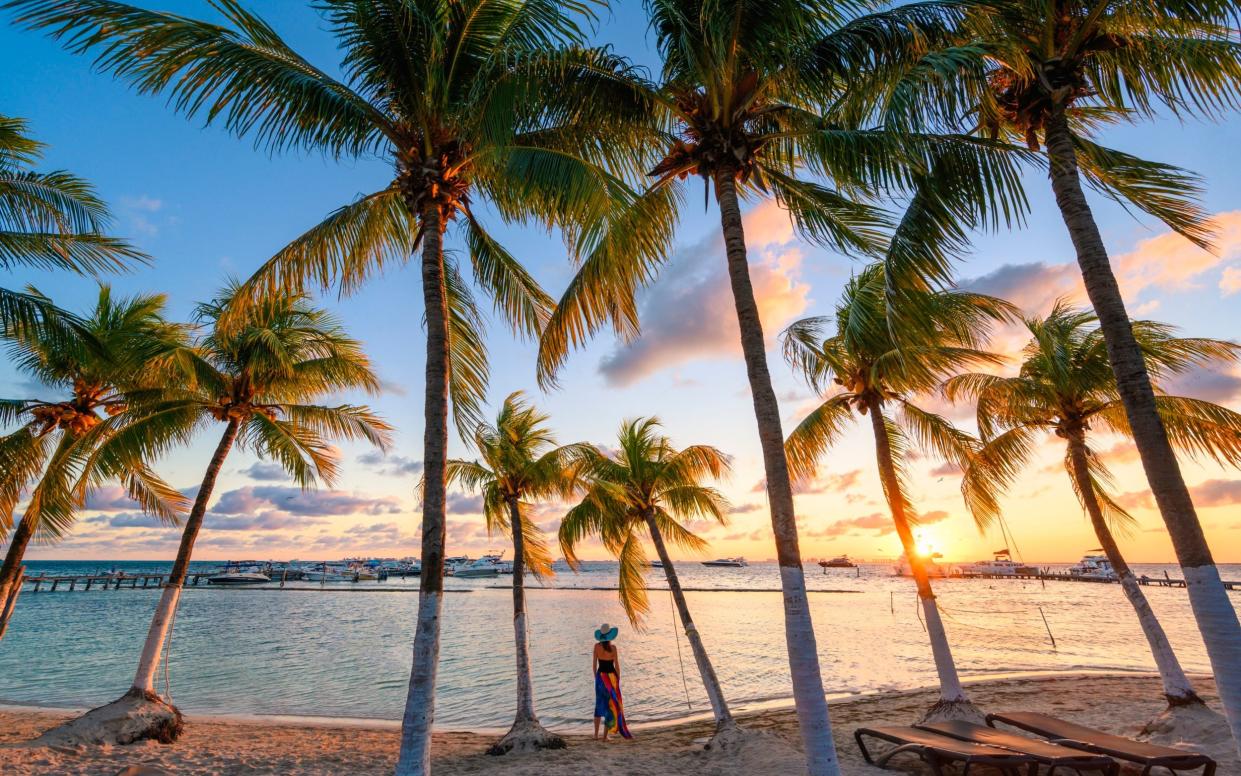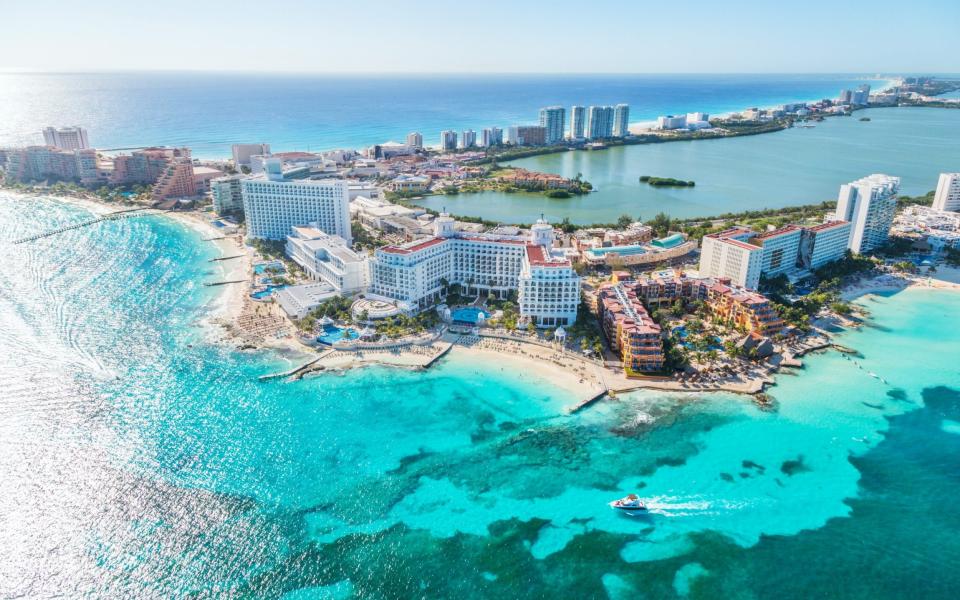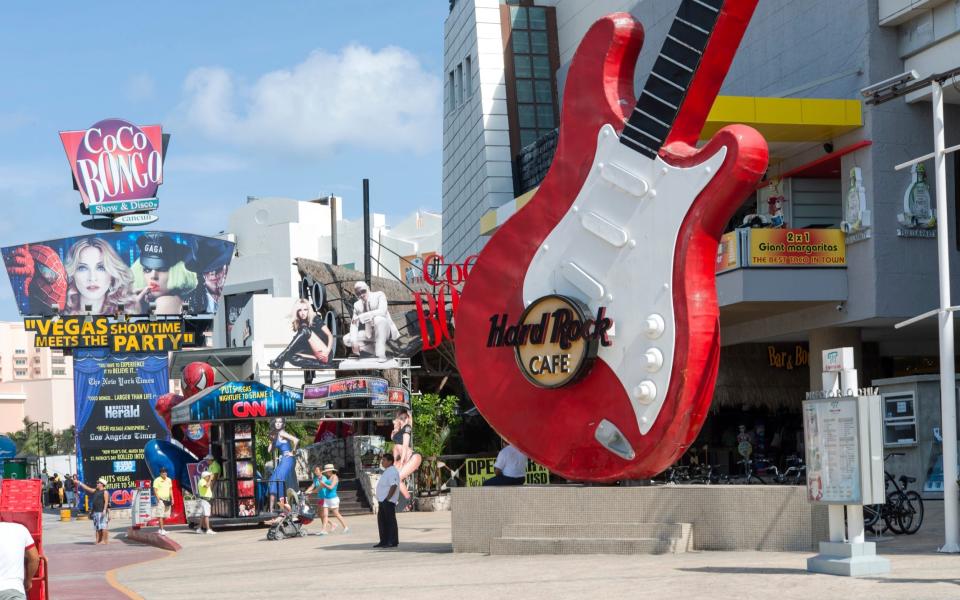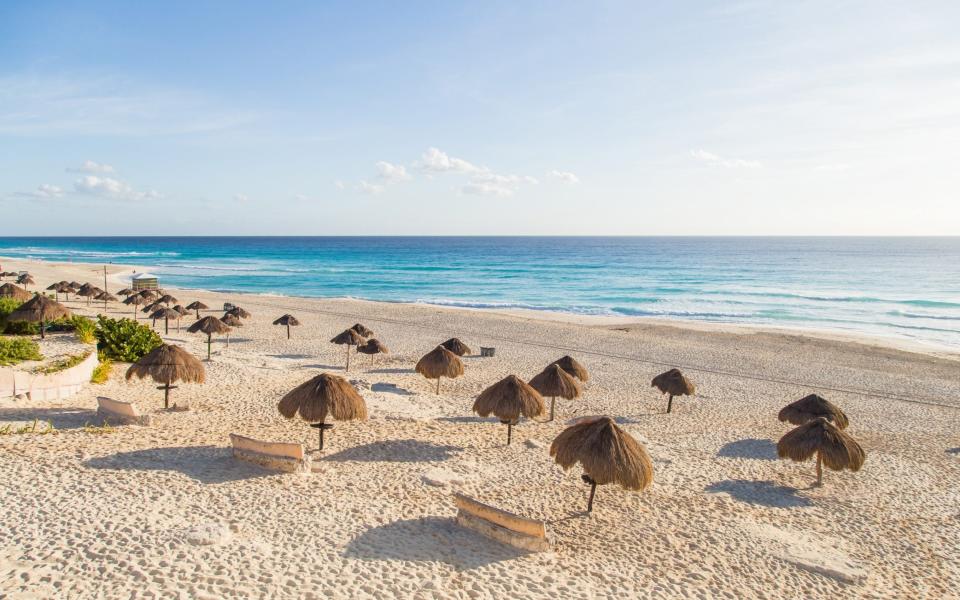How to visit Cancún and dodge the Spring Break crowds

Cancún divides opinions. The overdevelopment, the absence of cultural attractions, and the “inauthenticity” are not for everyone. But those who like it love it. Hang out there for a few days and you see why. The sun shines year round and, as the resort is just a couple of degrees south of the Tropic of Cancer, the average winter temperature is a balmy 73ºF (23°C). The beaches are long and white, the sea reef-calmed and turquoise.
Cancún hasn’t got as much history as other Mexican cities – but its evolution is interesting. The town was born in 1969 after architects, planners and tourism aces, sponsored by the Mexican government, studied resorts from Hawaii to the Caribbean to come up with an irresistible template. The market was readymade: vacationers from cooler northern Statues already went to Baja, San Miguel and other Mexican hotspots for winter holidays.
Cancún was envisioned as what one local media called a “multimillion-dollar playground". As was the fashion of the day – think Brasilia – it was planned by sectors: a “Hotel Zone” with high-rise hotels, shops, food and drink places, casinos and golf clubs; a main services hub (also known as El Centro); a residential area for workers. The gorgeous dune-backed white-sand beaches were already there, waiting for watersports and sunset canopies, cocktails and sunsets.
Over the years, the Cancún effect has traveled all down the south coast, now known as the Riviera Maya. Holiday scenes range from Mayakoba, a 500-acre enclave of luxury hotels, to the buzzing, densely developed town of Playa del Carmen to the small resort that has grown up around the extraordinary Mayan site of Tulum. Some regular Riviera vacationers prefer to hide away on offshore islands like Cozumel, Isla Mujeres or Isla Holbox, while others prefer to combine Cancún with a stay at a luxury hacienda deep inside Yucatán.
As for there being no culture, most people in Cancún make at least one trip per holiday to the Mayan citadel of Chichén Itzá, but there are dozens of other sites, large and small, to thrill even the most demanding archaeology buffs.

Given the long northern winters, it’s little wonder Cancún has become a Spring Break classic; it delivers all of the above, plus fun, games, night clubs and tequila slammers, and, like most major resorts, it has something to suit any budget. But the arrival of fiesta-seeking, mainly 18-30 hordes doesn’t mean the coast is taken over by techno and pool parties. With a bit of clever planning, you can have your own kind of vacation – while the Spring Break crowd have theirs.
When to go to Cancún
Cancún is an all-season destination. Between May and August, the rainy season, there are showers, but they are usually brief. The average high is 93ºF (34°C) in summer. The hurricane season spans June to November; the last major hurricane to make landfall here was Wilma in October 2005.
Independence Day – celebrated on September 16 – is a major fiesta, with music, parties, marching and formal ceremonies.
How to enjoy or avoid the crowds during Spring Break
Spring Break runs from late February through to April. During the first week to ten days, Cancún is usually not too overcrowded. March 5 to 25 2023 is the peak period, with intense partying by Americans, Canadians, Brazilians, Europeans, and others. March 25 to April 1 is a wind-down, so some fiestas and chilling out – and a great time to begin your vacation.
If you happen to be here during Spring Break, unless you’re a keen clubber you should avoid “dancing catamaran cruises” and pounding dance spaces like Coco Bongo, Cancún’s most famous nightclub, and the Mandala Beach pool party.
Some Cancún hotels pride themselves on their floorshows and party atmosphere. At the Grand Oasis the massive pool becomes a dancefloor with international DJ sets.

Where to stay
Most major hotels are inside the Hotel Zone looking out onto Playa Delfines, the 12-mile long spit of white sand that separates the Nichupte Lagoon from the Caribbean Sea. They range from mid-market to ultra-luxury, with several five star properties like the JW Marriott Cancun Resort & Spa, Hard Rock Cancun, SLS Cancun Hotel & Residences and Kempinski Grand, until recently a Ritz Carlton hotel.
There are adults-only hotels, such as the Hyatt Zilara resort and Le Blanc Spa, both all-inclusives. There are also lots of family-friendly resorts. Affordable options tend to be clustered off the main beach, to the north and west of the Hotel Zone. There are more hotels along the skinny Isla Blanca peninsula than juts out of Cancún to the north. In El Centro are two-star, condos and Airbnb options. The airport is 15-20 minutes away from most hotels.
Five of the best all-inclusive resorts in Cancún:
*Prices quoted are for double rooms, per night, mid-Spring Break.
Paradisus Cancún, part of the Meliá chain, is a striking array of five interconnected pyramids housing indoor tropical gardens, guest rooms and top-notch restaurants. Junior suite lagoon view from $477 (£393).
Moon Palace is a family-friendly all-inclusive with teen and kids’ areas, a spa and a Jack Niklaus golf course. Superior junior suite from $600 (£495).
Secrets The Vine’s soaring tower makes for superb views of the Caribbean, Nichupté Lagoon and the Cancún skyline. Its “Unlimited Luxury” concept includes perks like 24-hour gourmet meals and top-shelf drinks, all-day activities, and live entertainment. Run of the House room from $712 (£587).

Hyatt Ziva, on the Punta Cancún peninsula, is surrounded by the Caribbean Sea on three sides. It has contemporary furnishings, stylish restaurants and bars and the Punta Vista rooftop infinity pool – one of Cancún’s outstanding locations. Ocean front master from $1,064 (£877).
Le Blanc Spa Resort is designed for couples. The staff are one step ahead, and butlers help with unpacking, preparing baths and aromatherapy treatments. Royal deluxe lagoon view from $1,021 (£842).
See more of the best hotels in Cancún in our guide.
The best haciendas in Cancún
These beautiful estates, built between the 17th and 19th centuries, are dotted around the Yucatán peninsula, with most concentrated in the west. They grew up around the spiky agave plant that produces henequen, a fiber similar to sisal used in twine, rope, paper, wall coverings and carpets. Each property has a distinctive architecture, history and ambience. Historic and very tranquil, they make for a delightful contrast with Cancún.
Hacienda Chichen has nicely decorated rooms and verdant gardens and is ideal for overnighting before making an early start at Chichén Itzá.
Further afield (and more upmarket), Hacienda Temozon is a Marriott Luxury Collection hotel on the Mérida-Uxmal road.
The best things to do in Cancún
Cancún is, above all, a place to bathe and sunbathe, eat great food, enjoy a good book, relax by day, catch up on sleep and enjoy the sultry temperatures. But it is also a great base for a wide range of experiences and adventures. Offshore is the Mesoamerican barrier reef, a 700-mile long visual wonder of the world and precious nature reserve. More exciting (and environmentally sensitive) than renting a jet ski is to take off on a diving or snorkeling excursion and meet the local tropical fishes, rays, sea turtles and whale sharks.
Inland lie fabulous Mayan sites, nature reserves, cenotes (sinkholes), dreamy haciendas, Mayan villages, Spanish colonial-era towns and the lovely old city of Mérida – which was also the main regional airport before Cancún happened.
Wild activities
There are diving and snorkeling sites near to Cancún, including Punta Nizuc, at the southern end of the main beach, Playa Delfines, on Isla Mujeres (a 15-minute ferry ride away), and, most famously, at Musa, a quirky submarine sculpture museum. There are also day trips on offer to explore nearby cenotes and underwater cave systems that feature an option to dive. Beginners can take PADI scuba diving courses at several schools around Cancún.

Nature lovers will enjoy the day trip to Isla Contoy, an uninhabited island that’s home to more than 150 tropical bird species and four species of sea turtle; it’s good for hiking, bird-watching and snorkeling.
On the beach, water activities range from swimming and kayaking to kiteboarding and parasailing. SUP and kayak excursions are also available inside the lagoon system centered around the Laguna Nichupte.
Family-friendly parks
Hiking around a Mayan site is hot work and for all the educational value, too much guided touring can be tough for kids. To provide family-friendly entertainment, amusement and water parks have popped up all along the Riviera Maya. Some emphasize the region’s natural and cultural qualities, others deliver artificial theme park and fairground-style fun.
Xcaret, just over an hour’s drive south of Cancún, is the best-known park. It combines a Mayan ruin, cenotes and a turtle-nesting site with folk dancing shows and impressive horse riding displays. Admission is $110 (£91) for adults, $82 (£68) for children. Part of a major amusement park chain, Xcaret is offering 25 per cent discounts for Spring Break visitors who book into two parks.
Ventura, close to the airport, has a water park, zip line, dolphin encounter, rides and go-karts. Adults pay from $38 (£32), children from$30 (£25). Selvatica, about an hour’s drive away, has ten ziplines, an “aquazip”, bungee swings and a 4x4 adventure drive. Tickets for a full-day package are priced at $140 (£116) for adults and $99 (£82) for children.
Visit the Mayan sites
The Mayan civilisation, which endured for three millennia, stretched from Guatemala to El Salvador. The Yucatán peninsula is a great place to get an introduction to the phenomenal architecture, strange deities and sophisticated calendars, taking in the popular sites of Chichén Itzá (where it pays to start early before the crowds arrive) and Tulum, as well as the less visited Uxmal and Kabah ruins.

Before you jump on a bus to a Mayan site, pop into the Museo Maya de Cancún, a seriously good museum that displays around 400 ancient artifacts. The San Miguelito archaeological site next door had its apogee in the 13th and 14th centuries and contains residential platforms, palaces and an imposing pyramid. The El Rey archaeological site is just off the main hotel strip, and contains a small temple and ceremonial platforms.
Try the best food in Cancún
Mexican cuisine is popular for its color and complexity and Cancún is a great place to explore it. El Centro is where to try street food or take it easy at a taco joint – Parque de las Palapas is a popular meeting, greeting and eating hub – while the Hotel Zone has plenty of upmarket restaurants. Along the beach, thatch-roofed, terraced restaurants serve excellent fresh fish and seafood.
Safety and security
You may have seen news that Texan authorities have warned US citizens against traveling to Mexico. This local advice, a response to the murder of two tourists following a kidnapping, relates to the border area that has been notoriously unsafe for decades. The current government advice deems Cancún and all of the Yucatán peninsula safe for travel – check the latest at travel.state.gov.


